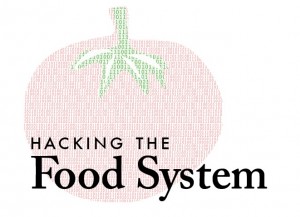 [Due to the overwhelming response to our series Hacking the Food System, Food+Tech Connect will be continuing the conversation each Wednesday with a new post from a thought leader in the field. Read past posts exploring how technology, information and data can change the food system status quo and follow along as the conversation continues on Twitter (hashtag #foodtech), or Facebook.]
[Due to the overwhelming response to our series Hacking the Food System, Food+Tech Connect will be continuing the conversation each Wednesday with a new post from a thought leader in the field. Read past posts exploring how technology, information and data can change the food system status quo and follow along as the conversation continues on Twitter (hashtag #foodtech), or Facebook.]

The Farmers Almanac 2.0: Hacking for Climate Change Emergency Preparedness
Top News Headlines October 2011: “Thailand Flood Reaches Bangkok.” “Heat Wave Causes Exploding Sidewalks and a Blood-Red Reservoir in Texas.” “Jellyfish numbers surge due to climate change.” “NY Regional Farms Devastated by Flooding.”
For a community that has been plagued by heat, flooding, or tornadoes – climate change has no longer become a fad or theory concocted by a team of scientists in a laboratory in Colorado. It is a reality.
For so many agricultural [land + sea] communities across the world, prolonged monsoons, disappearing watersheds, rising wind and storm patterns have disrupted 100+ year growth cycles, crop cycles, and ecological patterns. Millions of farmers around the world are increasingly finding themselves front line defenders of their land and their farms and trying to establish baseline preparedness, in a world where climate has grown ever more unpredictable-and ever more furious. I can’t help but wonder if the traditional ways of predicting weather by understanding cloud patterns and behavior of livestock will hold up in the face of such an unpredictable, and seemingly unstable climate scenario.
So how can the technology available today help to support disaster preparedness and provide key critical information inputs to support farming communities to manage climate change impacts? In other words, what does the Farmers Almanac 2.0 look like?
I propose that in order to support the agro-community, specifically farmers, to be prepared to deal with climate change impacts, the technology community must create: 1) A sophisticated and user friendly platform to mine agro-data inputs and develop cross platform functionality, and 2) Bridge the digital divide for farmers throughout the world.
Technology is a critical platform for communication between farmers on the front line and could enable farming communities to access the information needed to help them prepare and mange their land in the face of perilous ruin. What is needed however, is the infrastructure to provide for a comprehensive, regional interface that would incorporate inputs related to climate impacts; inputs like regional weather patterns related to humidity, heat, and wind; changes in local and regional water tables and water quality; wind and storm patterns; telemetric readings on related equipment and field sites, as well as land use patterns and significant infrastructure developments like dams and major highways.
But what if this system could go further and calculate the economy of the market, changing political systems and legal impacts to farmers, as well as understand how to give collective voice and support to farming communities regarding funding, legal issues, and property rights?
The good news is, the tools have been invented. Through advances made in the technology of telemetry, real time remote measurement and conveyance of remote information from field stations, farm or marine location can be made in a central hub which can be a computer, physical field station, phone, radio, personal computer. Ambient temperature, humidity, ground well levels, changes in precipitation, solar radiation, wind speed, and even rates of evapo-transpiration can be monitored.
What if we were to use the same technology and monitor socio-economic inputs and overlay those onto a platform that engages a full array of currently monitored inputs? In Georgia, for example, some of these inputs are already on line via the state cotton commission which is constantly monitoring the latest legal and political developments in the cotton industry, as well as any anomalies to be expected in the growth of cotton as a result of unusual weather patterns.
But if there is no access to this robust platform, it cannot benefit the most challenged agro-communities, particularly those farmers in rural regions that ironically are facing some of the most drastic climate change impacts. Bridging the digital divide and creating access to agro-data is the penultimate issue in creating universal preparedness for agro-communities in the face of climate change . In the US alone, to date, only 62% of Rural American farmers have access to the internet. Consider farmers in Bangladesh, at the foot of the largest water sink in the world, or fishermen in Aleppey, India who are are facing rising temperatures in the sea, or farming communities in Eastern China faced with the uncertainty of where their potable water will be coming from to feed their livestock and their crops?
If the climate around the world continues to change (and all evidence to date supports this theme), so many agro-communities across the globe whose livelihoods depend on weather, the land, natural resources, will be looking down a road that is growing wetter, drier, windier, and less arable. It is all the more critical that technological pioneers (i.e. agro-hackers) start to build a more robust, vigilant, and accessible monitoring system to support those at the front line of climate change impacts. Then farmers will be able to manage their farms and their lives, in the face of Mother Nature’s fury.
_______________________
Laurie Schoeman is an experienced environmental leader with expertise in green building design and construction, urban sustainability, organizational development, and financial planning, Laurie was the appointed representative from SF’s District 10 to the San Francisco Public Utilities Commission where she chaired the Environmental Justice Advisory committee and worked with the PUC commission to pass the nation’s first EJ policy in any public utility. Laurie has spent over a decade working with a diverse spectrum of communities in development, education, and planning for and with a variety of nonprofits and public agencies both in New York, Chicago, and San Francisco for a variety of organizations including: UNEP-UNHABITAT, Catholic Charities, MIG, City of Alameda, City of NY DOT, City of San Francisco, State of California, Environmental Protection Agency, and Urban Habitat.





